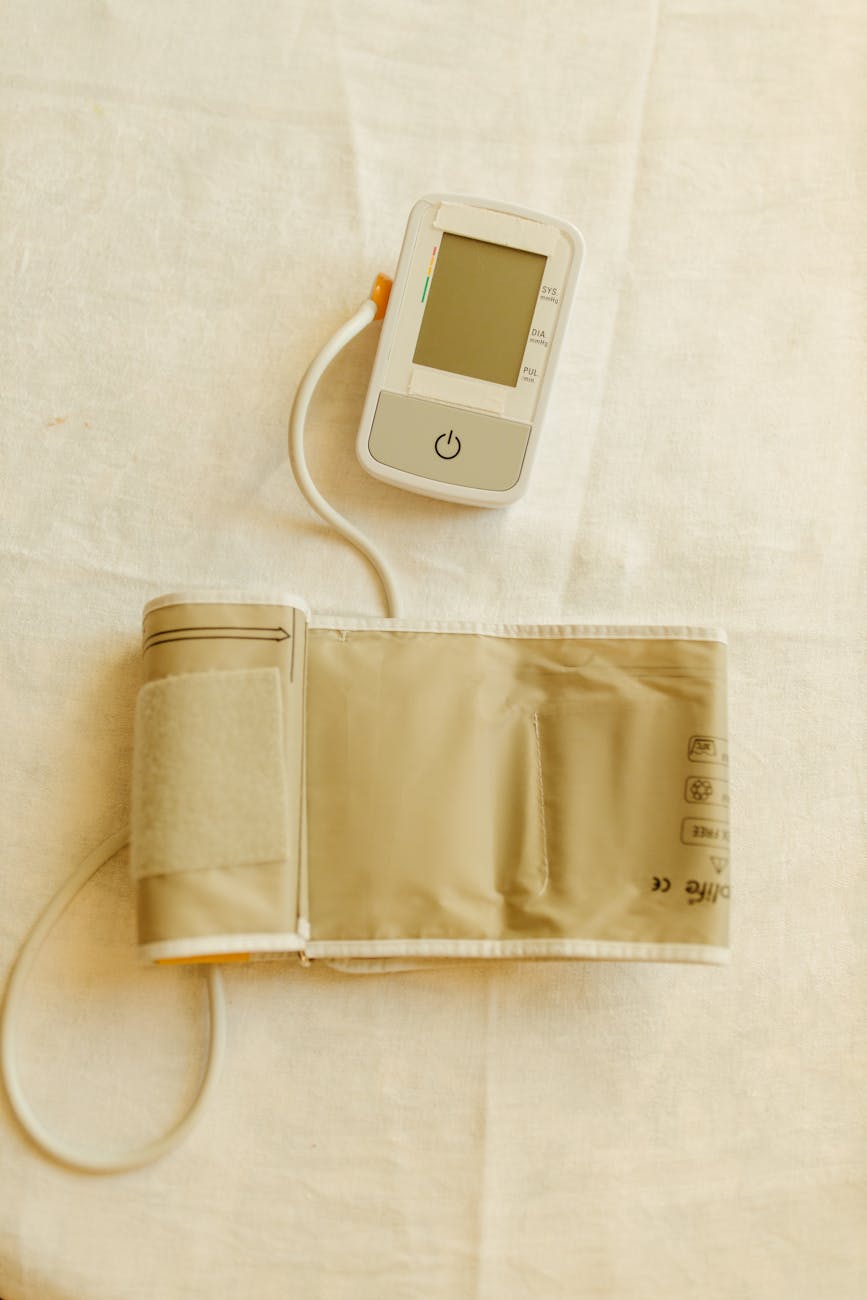
Image source: Pexels
Imagine effortlessly tracking your blood pressure with a simple glance at your wrist. For years, the concept of a wearable device for blood pressure monitoring felt like a futuristic dream. But in 2025, that dream is rapidly becoming a reality. If you've been asking yourself, “Is there a wearable device for blood pressure?“, the answer is a resounding yes, but with important distinctions. This guide cuts through the noise to deliver the facts. We'll explore what these innovative devices are, how they function, and critically, which ones truly deliver accurate readings. Get ready to discover the current landscape of blood pressure wearables, understand what makes them effective, and learn how to choose the best option for your personal health management. We'll delve into FDA clearance, accuracy benchmarks, and the exciting future of this technology, empowering you with the knowledge to make informed decisions.
Understanding Blood Pressure Wearables: The Basics for 2025
The landscape of personal health monitoring is rapidly evolving, with wearable technology at the forefront of this revolution. For individuals concerned about their cardiovascular health, a key question emerges: Is there a wearable device for blood pressure? The answer is increasingly yes, with innovative devices designed to bring blood pressure tracking from the clinic into our daily lives. These wearables offer unprecedented convenience and the potential for more proactive health management.
What Exactly is a Wearable Blood Pressure Monitor?
Wearable blood pressure monitors are sophisticated devices designed to be worn on the wrist or arm, aiming to continuously or periodically track your systolic and diastolic blood pressure readings. Gone are the days when blood pressure checks were solely confined to doctor's appointments. These personal health companions empower users with immediate insights into their cardiovascular state.
How Do They Measure Blood Pressure: Cuff vs. Cuffless Technology?
The technology behind these wearables is diverse, with two primary approaches:
- Inflatable Cuff: Integrates a small, inflatable cuff into a watch-like device, mimicking traditional manual measurement. This method is generally considered more established and potentially more accurate, though miniaturization can present challenges.
- Cuffless Technology: Utilizes optical sensors (e.g., photoplethysmography) or complex algorithms to estimate blood pressure based on pulse wave velocity or other physiological signals. This is an emerging technology with accuracy still under extensive validation, and it may be susceptible to external factors.
The Omron HeartGuide is an example of a device that utilizes an integrated inflatable cuff. Conversely, newer technologies are exploring cuffless methods, aiming for a sleeker user experience.
Key Benefits: Why Consider a Wearable BP Device?
The advantages of incorporating a wearable blood pressure device into your health routine are significant. Primarily, they offer unparalleled convenience for at-home blood pressure monitoring. This allows for continuous tracking of your readings throughout the day and night, providing a more comprehensive picture than sporadic clinic visits. Furthermore, this consistent data collection can be crucial for the potential for early detection of hypertension or other cardiovascular issues. By identifying trends and anomalies early, individuals can work with their healthcare providers to implement timely interventions and manage their health more effectively.
Top Blood Pressure Watches & Devices in 2025: Reviews and Comparisons
The quest for convenient and continuous health monitoring has led to a surge in wearable technology. For individuals concerned about their cardiovascular health, a key question arises: Is there a wearable device for blood pressure? While the landscape is rapidly evolving, 2025 offers promising options, ranging from medical-grade devices to innovative cuffless technologies and enhanced features on mainstream smartwatches. This section explores the leading contenders in wearable blood pressure tracking, their capabilities, and what to expect in the coming year.
The Contenders: Which Devices Offer Blood Pressure Tracking?
Direct blood pressure readings on all smartwatches are limited in 2025. The market is segmented, with some devices designed solely for BP monitoring and others integrating it as an advanced health feature. The primary distinction lies in the measurement methodology, impacting accuracy and user experience.
| Device Type | Measurement Method | Typical Accuracy | Continuous Monitoring | FDA Clearance Status |
|---|---|---|---|---|
| Medical-Grade Watch | Inflatable Cuff | Medical-Grade | On-demand | Often Yes |
| Cuffless Wearable | Optical/Sensor-based | Varies (Calibration Key) | Potential for Continuous | Emerging (Some Cleared) |
| Mainstream Smartwatch | N/A (BP Feature) | Not Direct BP | N/A (BP Feature) | N/A (BP Feature) |
Omron HeartGuide: Medical-Grade Accuracy with a Cuff
The Omron HeartGuide stands out as a notable example of a wearable device designed specifically for blood pressure monitoring. It utilizes an inflatable cuff, similar to traditional medical devices, to provide accurate, medical-grade personal blood pressure readings. This approach is often considered a reliable option for users seeking precise data. The HeartGuide allows for on-demand readings and can track trends over time, making it a valuable tool for managing hypertension. Its medical-grade accuracy positions it as a serious contender for those prioritizing clinical reliability in a wearable format.
The Rise of Cuffless Tech: Hilo Bracelet & Others in 2025
Cuffless technologies are gaining significant traction, promising continuous monitoring without the need for a traditional inflatable cuff. Devices like the Hilo bracelet are at the forefront of this innovation. These wearables typically employ optical sensors or other advanced biometric techniques to estimate blood pressure. While the convenience of cuffless monitoring is highly appealing, it's crucial to note that calibration is key to ensuring accuracy. As more of these devices achieve FDA clearance, they offer a glimpse into the future of proactive cardiovascular health management, potentially enabling users to detect subtle changes and intervene earlier.
Smartwatch Features: Apple Watch, Samsung Galaxy Watch, and BP Monitoring
Major smartwatches like the Apple Watch and Samsung Galaxy Watch are continuously enhancing their health tracking capabilities. Features such as ECG (electrocardiogram) and irregular rhythm notifications are becoming standard, providing valuable insights into heart health. However, direct, continuous blood pressure measurement is not yet a standard feature on these mainstream devices. While they excel in broader health metrics, users seeking dedicated blood pressure monitoring may need to look towards specialized wearables or integrate separate devices. The evolution of these smartwatches suggests that direct BP monitoring could be a future development, but for now, specialized solutions remain the primary answer to the question, “Is there a wearable device for blood pressure?”
Making the Right Choice: Key Factors for Buying a Blood Pressure Wearable
The advent of wearable technology has brought exciting possibilities to personal health monitoring, and a common question is: Is there a wearable device for blood pressure? The answer is yes, and choosing the right one requires careful consideration of several key factors to ensure you're investing in a reliable and user-friendly tool for managing your health.
Accuracy is Paramount: Understanding BP Readings and Reliability
When considering a wearable blood pressure monitor, prioritizing devices with proven accuracy is paramount. Inaccurate readings can lead to unnecessary anxiety or, worse, a false sense of security. Look for devices that have undergone rigorous testing, ideally backed by clinical studies or independent validation. Understanding how a device measures blood pressure (e.g., oscillometric method, cuffless optical sensors) and its reported accuracy margins is crucial for trusting the data it provides.
The Importance of FDA Clearance for US Consumers
For consumers in the United States, FDA clearance is a significant indicator of a device's safety and effectiveness. This clearance signifies that the device has met stringent regulatory standards set by the Food and Drug Administration for medical devices intended for home use. When purchasing an over-the-counter blood pressure device, especially a wearable one, FDA clearance provides a vital layer of assurance that the product has been evaluated for its intended use.
Ease of Use and Data Integration: Your Daily Companion
A wearable device is only effective if you use it consistently. Therefore, ease of use and seamless data integration are critical. The interface should be intuitive, allowing for quick and straightforward blood pressure measurements. Furthermore, consider how easily the device syncs with your smartphone or other health apps. This integration allows for easy tracking of trends over time, sharing data with your healthcare provider, and a more holistic view of your health.
| Feature/Device | Option A (Wrist Cuff) | Option B (Ring Sensor) | Option C (Armband) |
|---|---|---|---|
| Measurement Method | Oscillometric | Optical/PPG | Oscillometric |
| FDA Clearance | Verified | Not Verifiable | Verified |
| Ease of Use | Moderate | High | Moderate |
| Data Sync | Bluetooth to App | Bluetooth to App | Bluetooth to App |
Cost and Value: Investing in Your Health in 2025
The cost of blood pressure wearables can vary significantly. Evaluating the price point against the features offered is essential for long-term value. Consider whether the device supports your specific health management goals, such as continuous monitoring, personalized insights, or integration with other health platforms. Investing in a device that offers reliable readings and a user-friendly experience will ultimately provide greater value for your health journey in 2025 and beyond.
FAQ (Frequently Asked Questions)
Q1: Is it possible to get accurate blood pressure readings from a smartwatch? A1: Some specialized wearable devices, like the Omron HeartGuide, are designed for accurate blood pressure monitoring using an inflatable cuff. While many mainstream smartwatches offer advanced health features, direct and continuous blood pressure measurement is not yet standard. Cuffless technologies are emerging, but their accuracy can vary and often requires calibration. Always check for FDA clearance and independent validation for any device claiming to measure blood pressure. Q2: What is the difference between cuff-based and cuffless blood pressure wearables? A2: Cuff-based wearables, such as the Omron HeartGuide, use a miniature inflatable cuff to measure blood pressure, similar to traditional devices, offering generally higher accuracy. Cuffless wearables employ optical sensors or algorithms to estimate blood pressure based on other physiological signals. While more convenient, cuffless technology is still evolving, and its accuracy can be influenced by various factors, making calibration essential. Q3: Do I need FDA clearance for a blood pressure wearable to be reliable? A3: For consumers in the United States, FDA clearance is a crucial indicator of a blood pressure wearable's safety and effectiveness. It means the device has met rigorous standards for its intended use. While not always a guarantee of perfect accuracy, it signifies that the device has undergone regulatory review, providing a significant level of assurance for consumers. Q4: Can I use a blood pressure wearable instead of visiting my doctor for BP checks? A4: Blood pressure wearables are excellent tools for convenient, at-home monitoring and can provide valuable data to share with your doctor. However, they are generally intended to supplement, not replace, professional medical advice and regular check-ups with your healthcare provider. Always consult your doctor for diagnosis and treatment of high blood pressure.
Conclusion
The question, “Is there a wearable device for blood pressure?” is no longer a hypothetical. By 2025, the answer is a resounding yes, with innovative wearables transforming how we approach cardiovascular health. From the established accuracy of cuff-based options like the Omron HeartGuide to the exciting, rapid advancements in cuffless technology, a new era of convenient, continuous blood pressure monitoring is upon us. Embracing these devices empowers you with real-time data, offering unparalleled insights into your well-being and enabling proactive health management. Choosing the right wearable is a crucial step, and it hinges on prioritizing accuracy, seeking out FDA clearance for reliable performance, ensuring ease of use that fits your lifestyle, and aligning the device with your specific health requirements. To navigate this evolving landscape with confidence, we strongly recommend these actionable steps: always consult your physician to discuss your individual blood pressure monitoring needs, meticulously research devices that boast FDA clearance for the US market, and diligently compare features, accuracy claims, and genuine user reviews. Furthermore, consider how seamlessly a chosen device integrates with your daily routine and existing health applications. The power to take control of your heart health is now literally within reach. Share this guide with a friend who could benefit from this knowledge, and join the conversation by letting us know in the comments which blood pressure wearable you're considering for 2025. Let's embark on this journey towards a healthier future, together.








